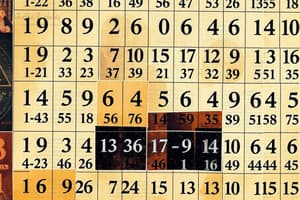Podcast
Questions and Answers
The first multiple of 2 is ______.
The first multiple of 2 is ______.
2
In the table of 5, 3 x 5 equals ______.
In the table of 5, 3 x 5 equals ______.
15
The multiple following 24 in the table of 6 is ______.
The multiple following 24 in the table of 6 is ______.
30
The pattern of the table of 3 includes adding ______ to the previous result.
The pattern of the table of 3 includes adding ______ to the previous result.
The fifth multiple of 4 is ______.
The fifth multiple of 4 is ______.
In the table of 5, 1 x 5 equals ______.
In the table of 5, 1 x 5 equals ______.
Flashcards are hidden until you start studying
Study Notes
Table of 2
- Multiples: 2, 4, 6, 8, 10, 12, 14, 16, 18, 20
- Pattern: Each number is obtained by adding 2 to the previous result.
- Example:
- 1 x 2 = 2
- 2 x 2 = 4
- 5 x 2 = 10
Table of 3
- Multiples: 3, 6, 9, 12, 15, 18, 21, 24, 27, 30
- Pattern: Each number is obtained by adding 3 to the previous result.
- Example:
- 1 x 3 = 3
- 2 x 3 = 6
- 5 x 3 = 15
Table of 4
- Multiples: 4, 8, 12, 16, 20, 24, 28, 32, 36, 40
- Pattern: Each number is obtained by adding 4 to the previous result.
- Example:
- 1 x 4 = 4
- 2 x 4 = 8
- 5 x 4 = 20
Table of 5
- Multiples: 5, 10, 15, 20, 25, 30, 35, 40, 45, 50
- Pattern: Each number is obtained by adding 5 to the previous result.
- Example:
- 1 x 5 = 5
- 2 x 5 = 10
- 5 x 5 = 25
Table of 6
- Multiples: 6, 12, 18, 24, 30, 36, 42, 48, 54, 60
- Pattern: Each number is obtained by adding 6 to the previous result.
- Example:
- 1 x 6 = 6
- 2 x 6 = 12
- 5 x 6 = 30
Table of 7
- Multiples: 7, 14, 21, 28, 35, 42, 49, 56, 63, 70
- Pattern: Each number is obtained by adding 7 to the previous result.
- Example:
- 1 x 7 = 7
- 2 x 7 = 14
- 5 x 7 = 35
Table of 2
- Multiples of 2 are: 2, 4, 6, 8, 10, 12, 14, 16, 18, 20.
- Each subsequent number increases by 2.
- Basic multiplication examples: 1 x 2 = 2, 2 x 2 = 4, 5 x 2 = 10.
Table of 3
- Multiples of 3 include: 3, 6, 9, 12, 15, 18, 21, 24, 27, 30.
- Numbers are generated by adding 3 to the previous multiple.
- Basic multiplication examples: 1 x 3 = 3, 2 x 3 = 6, 5 x 3 = 15.
Table of 4
- Multiples of 4 are: 4, 8, 12, 16, 20, 24, 28, 32, 36, 40.
- Each number is obtained by adding 4 to the preceding multiple.
- Basic multiplication examples: 1 x 4 = 4, 2 x 4 = 8, 5 x 4 = 20.
Table of 5
- Multiples of 5 encompass: 5, 10, 15, 20, 25, 30, 35, 40, 45, 50.
- The pattern involves adding 5 to the previous multiple.
- Basic multiplication examples: 1 x 5 = 5, 2 x 5 = 10, 5 x 5 = 25.
Table of 6
- Multiples of 6 are: 6, 12, 18, 24, 30, 36, 42, 48, 54, 60.
- Each subsequent number results from adding 6 to the prior multiple.
- Basic multiplication examples: 1 x 6 = 6, 2 x 6 = 12, 5 x 6 = 30.
Table of 7
- Multiples of 7 include: 7, 14, 21, 28, 35, 42, 49, 56, 63, 70.
- The sequence is generated by adding 7 to the last multiple.
- Basic multiplication examples: 1 x 7 = 7, 2 x 7 = 14, 5 x 7 = 35.
Studying That Suits You
Use AI to generate personalized quizzes and flashcards to suit your learning preferences.




